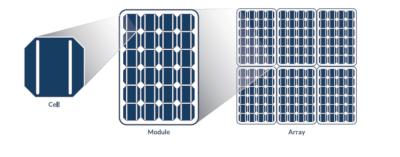This article is an extract from The Perovskite Handbook, 2020 edition, and explains the current market status of Perovskites Solar Panels.
Solar Panels is the most prominent potential perovskite application, as synthetic perovskites are recognized as inexpensive base materials for high-efficiency commercial photovoltaics. Perovskite PVs are constantly undergoing research and improvement, going from just 2% in 2006 to over 23% today, and constantly improving. Experts forecast that the market for perovskite PV will reach $214 million in 2025.

Power efficiency is obviously a key metric for solar power technologies. In this article we'll explain how solar system efficiency is defined and the current power efficiency market status of PSCs.
Basic solar definitions
PV cell
The basic component of a photovoltaic (PV) system is the photovoltaic cell, or solar cell. A solar cell is a semiconductor device able to convert solar energy into electricity through the photovoltaic effect. The size of a PV cell is limited by the process used to produce it.
PV panel / module
A single PV cell can only generate a limited amount of electricity, and so to increase the electricity collected to a point where it is enough to use in everyday applications, a number of cells can be interconnected in a sealed, weatherproof package called a panel / module. So, when multiple solar cells are connected as an integrated group, all oriented in one plane, a solar photovoltaic panel or module is created. In general, it can be said that the number of series cells indicates the voltage of the module, whereas the number of parallel cells indicates the current.
The interconnection and packaging of the panel results in some efficiency loss.
PV Array
To increase the collected voltage and current, PV modules can be wired in series and parallel into what is called a PV array. The flexibility of the modular PV system allows to create solar power systems that can meet a wide variety of electrical needs.
In a similar way to PV modules, the interfaces and packaging can result in efficiency loss.

PV system
A PV system is the full, end product - and may include, in addition to the PV Module (one or more or arrays, of course): a charge controller, batteries ( if it's a standalone system), power inverter, and more. The PV module converts the solar light energy into DC electrical energy. The charge controller conditions the DC electrical voltage and current produced by the PV module to charge a battery, if needed. The battery can store the DC electrical energy so that it can be used when there is no solar energy available (night time, cloudy days etc). The inverter converts the DC power produced by the PV module / stored in the battery into AC power.

PV device
While the former definitions cover the traditional commercial types of solar components, PV devices is a term that relates to R&D usages.
Usually researchers and developers use small cell sizes in their lab experiments - small enough that these cannot truthfully be referred to as solar cells (even though companies will sometimes refer to these small devices as 'cells'.). Typical perovskite research device can range from 1 mm2 to 1 cm2. The efficiency of a small device may be higher than the efficiency of a larger cell structured in the same way.
PV mini module
Smaller PV modules are sometimes referred to as mini-modules. These are not meant for use in solar generation systems, but can be utilized in specific small-area applications (such as calculators or toys).

Perovskite solar efficiency achievements
In the past few years, several companies and researchers reported new records for perovskite solar technologies. While some of these achievements are very impressive, one must remember that various reports are difficult to compare as they sometimes relate to different sizes and technologies.
Oxford PV, for example, reported in June 2018 that it developed 27.3% perovskite-silicon tandem device (1 cm2). In December 2018, the Company announced a certified 28% efficiency world record for its silicon and perovskite tandem solar cell. This seems to be the best performing tandem cell for that time.
China's Microquanta announced in July 2018 that it has set a new record for a perovskite mini module - with an efficiency of 17.3%. The perovskite mini module contains 7 cells and is 17.277 cm2 in size. In October 2019, the Company achieved a 14.24% conversion efficiency record for a large-area (200x800cm2) perovskite solar module.
In April 2018, the EU Solliance project announced its best performing perovskite module yet. The 144 cm2 module has a stabilized efficiency of 13.8%. Each cell inside the module has an efficiency of 14.5%. In September 2019, Solliance and U.S-based MiaSolé announced a new record - power conversion efficiency of 23% on a flexible tandem solar cell: a top flexible semi-transparent perovskite solar cell with a bottom flexible copper indium gallium selenide (CIGS) cell.
In July 2018, Toshiba and NEDO announced an even larger perovskite module at 703 cm2. The efficiency of Toshiba's latest module is 11.7%.
This was an extract from The Perovskite Handbook, 2020 edition. The book gives an introduction to perovskite materials, the technology, industry and market.
 Reading this book, you'll learn all about:
Reading this book, you'll learn all about:
- Different perovskite materials, their properties and structure
- How perovskites can be made, tuned and used
- What kinds of applications perovskites may be suitable for
- What the obstacles on the way to a perovskite revolution are
- Perovskite solar cells, their merits and challenges
- The state of the perovskite market, potential and future
The perovskite book also provides:
- A history of perovskite research
- A guide to perovskite companies and developers
- Information on leading collaboration and development projects
- A comprehensive list of perovskite companies



